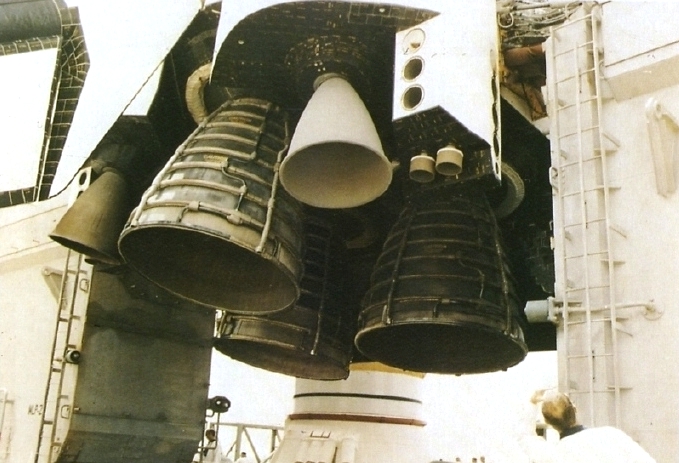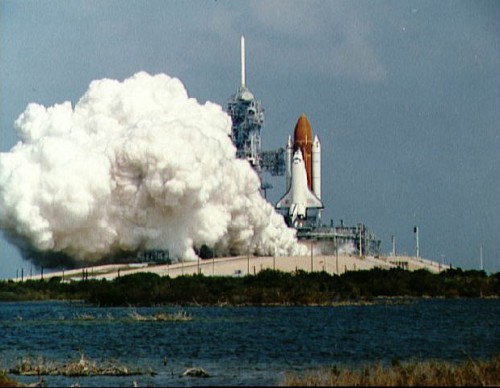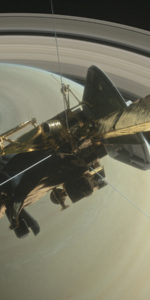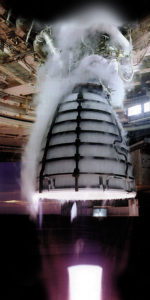
“T-minus 31 seconds…Endeavour’s four redundant computers have primary control of critical vehicle functions for the remainder of the count…”
Twenty-five years ago, Space Shuttle Endeavour—built in the aftermath of the Challenger disaster to replace her fallen sister—sat on Pad 39B at the Kennedy Space Center (KSC) in Florida, only weeks ahead of her maiden voyage into orbit. In time, Endeavour would cement her credentials by flying 25 missions, including history’s only three-person Extravehicular Activity (EVA), the critical first servicing of the Hubble Space Telescope (HST) and launching the initial components of the International Space Station (ISS). Yet on the morning of 6 April 1992, three weeks after rolling out to Pad 39B, Endeavour’s trio of Space Shuttle Main Engines (SSMEs) were test-fired in what wound up as the seventh and last Flight Readiness Firing (FRF) in the 30-year shuttle program.
“T-20 seconds. Sound suppression water will be released on the launch platform.”
The FRF was performed before each shuttle’s maiden voyage—and twice by Challenger and Discovery—and sought to impose launch conditions on the engines, as well as testing the suite of Auxiliary Power Units (APUs) in high-speed mode. Visibly and acoustically, it was perhaps the clearest example, other than a launch itself, of the orbiters straining against their shackles and yearning to fly. The Ground Launch Sequencer (GLS) had handed over primary control of the countdown to the shuttle’s on-board General Purpose Computers (GPCs) and the Solid Rocket Booster (SRB) Hydraulic Power Units (HPUs) had been activated shortly thereafter. At T-18 seconds, the SRB nozzle positions were verified and the quartet of giant “rainbirds” around the base of the launch pad were activated, ushering a flood of water to reduce the reflected energy, ahead of Main Engine Start.
“T-minus 12, 11, ten, nine…we have a Go for Engine Start…”
In a manner which had become instantly familiar over the preceding decade, a flurry of hydrogen burn igniters produced a shower of sparks, after which the three SSME bells at the extremity of Endeavour’s aft fuselage suddenly spouted a sheet of translucent orange flame. This was quickly replaced by a striking trio of dancing Mach-diamonds, as the shuttle’s on-board General Purpose Computers (GPCs) commanded the engines to full power.
“Six, five…we have Main Engine Start…two, one, zero…engines are now at 100 percent of rated power…”

And so they were. However, as Endeavour flexed against the struts which held her against her rust-colored External Tank (ET) and twin Solid Rocket Boosters (SRBs), the key difference was that on 6 April 1992 she was not yet ready to head into space. Part of the FRF protocol was to demonstrate her systems performance under rigorous test conditions, and under the closest possible conditions to actual flight, with her engines fired for 20 seconds. All control elements of Endeavour’s Main Propulsion System (MPS) were required to hold pressure in the engines and the ET and the flight control instrumentation was expected to provide proper throttling and gimbaling functions, thereby validating the integrated performance of the shuttle stack and the compatibility of the on-board GPCs with ground-based computers.
“Five, plus six, plus seven, plus ten, plus 11, plus 14…and we have an abort…”
As vast clouds of steam billowed from the pad, and after 15 seconds of stable thrusts, shutdown commands were issued to all three SSMEs.
“Engines 1, 2 and 3 are now showing post-shutdown standby,” called GLS, “and we are Go for orbiter APU shutdown.”
In total, the FRF lasted 22 seconds and was a great success, but for a couple of technical issues. High vibration levels were detected in one of the engines’ high-pressure liquid oxygen turbopumps, whilst another exhibited a loud “popping” noise shortly after shutdown, indicative of hydrogen ingestion into the fuel injector. Prudently, on 8 April 1992 NASA decided to replace all three SSMEs with a set previously earmarked for her sister ship Atlantis’ STS-46 mission in July, although a second flight readiness firing for Endeavour was not considered necessary.
As well as being the first and only FRF to occur on Pad 39B, this was also the final flight readiness firing of the Space Shuttle Program. The first FRF had taken place more than a decade earlier, on 20 February 1981, in the weeks preceding the launch of Columbia on STS-1, the first shuttle mission. Formally known as the “Wet Countdown Demonstration Test (WCDT)/Flight Readiness Firing (FRF)”, it was designed to test the complete shuttle stack—Columbia, her ET and her twin SRBs—“in a real-time launch countdown which will culminate in a firing of the orbiter’s three main engines and a simulated launch to ensure their proper integration prior to the STS-1 flight”.
Fundamentally, the FRF sought to “verify the capability of the launch facility to provide propellants to the shuttle under launch conditions,” with the ET and SRB stack “exposed to the same thermal environment they will experience during STS-1 launch preparations”. All MPS control elements were “required to maintain pressure in the External Tank and in the main engines during the test firing as they would during an actual launch”, whilst the ability of the APUs, hydraulic systems and flight controls were verified as being able to throttle the three SSMEs at between 94 and 100 percent, as well as gimbaling them to effect steering.”
When 20 February 1981 came around, the six-day WCDT was nearing its conclusion and would culminate in the FRF. In readiness for the test firing, launch controllers started the countdown clock at T-53 hours, when they powered up the SRBs, the Ground Support Equipment (GSE) and the shuttle’s on-board systems. Four seconds prior to the simulated liftoff, Columbia’s SSMEs roared to life at 120-millisecond intervals, reaching 90 percent of rated performance within three seconds and hitting 100 percent precisely at T-0. Three seconds later, engineers simulated the retraction of the ET umbilical and the SRBs’ hold-down posts; and after 15 seconds of stable thrust from the SSMEs, shutdown commands were issued to the engines. The test was a great success and cleared another critical milestone, ahead of the STS-1 launch.
One significant aspect of the FRF was to evaluate and measure the effect of the “twang”—the amount of movement in the orbiter, against the rest of the stack, during the SSME ignition sequence—and in the case of Columbia this induced a forward shift by about 25.5 inches (64.7 cm), which was somewhat greater than the 19 inches (48.2 cm) predicted. However, the twang remained within anticipated structural limits. Also, the spark-like hydrogen burn igniters were started at the same time as SSME ignition, but post-FRF analysis led to a decision to initiate this sequence at T-4.4 seconds ahead of Main Engine Start on STS-1 and all subsequent missions.
With Columbia’s FRF successfully concluded, the flagship of the Space Shuttle fleet went on to record her first five orbital missions over the course of the next 19 months. It was then the turn of her sister ship, Challenger, to enter final preparations for her maiden voyage. And as shall be explored in tomorrow’s AmericaSpace history article, Challenger’s career began with not one FRF, but two.
The second part of this article will appear tomorrow.
Be sure to “LIKE” AmericaSpace on Facebook and follow us on Instagram & Twitter!





